Barber J.R. Intermediate Mechanics of Materials
Подождите немного. Документ загружается.

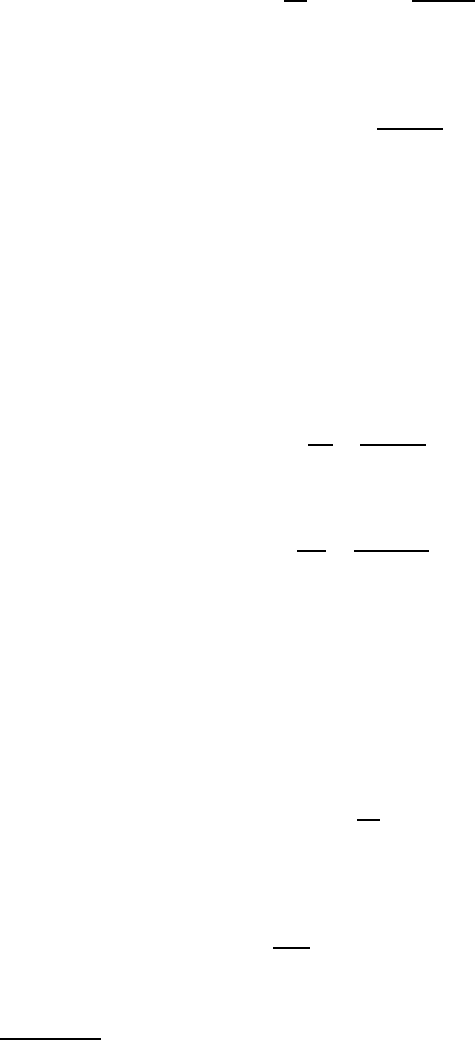
9.6 Shell transition regions 435
σ
cylinder
1
=
pa
2t
;
σ
cone
1
=
pa
2t cos
α
(9.31)
and axial equilibrium is satisfied.
5
To restore radial equilibrium, we would need to
add a force F
0
per unit circumference as in Figure 9.11 (c), where
F
0
=
σ
cone
1
t sin
α
=
pa tan
α
2
. (9.32)
In the actual shell, this force is not present and the transition zone therefore tends
to pull radially inwards under the influence of the membrane stresses until addi-
tional circumferential stresses are developed sufficient to oppose the unbalanced ra-
dial force.
The bending stresses near the discontinuity can be estimated by first assuming
that the force F
0
is provided. In this case, there will be some bending associated with
the discontinuity in u
m
r
between the cylinder and the cone, but it will be small. We
then remove the force F
0
, which is equivalent to applying an inward concentrated
radial load of the same magnitude. We have already solved this ‘corrective’ problem
in §9.5 and the maximum bending moment produced is
M
z
(0) =
F
0
4
β
=
pa tan
α
8
β
,
corresponding to a maximum bending stress of
σ
max
b
=
6M
t
2
=
3pa tan
α
4
β
t
2
.
Unless
α
is very small, this will be substantially larger than the membrane stresses,
which are of order pa/t.
One interpretation of the function of the toroidal transition is that is serves to dis-
tribute the force F
0
of equation (9.32) over the toroidal region, thereby reducing the
maximum bending moment it produces. Thus, we might regard the toroidal segment
as a sequence of infinitesimal changes of
α
at each of which an infinitesimal radial
force is required. As long as
α
is not too large, the change in
α
per unit axial length
is d
α
/dz= 1/R and the required inward radial force corresponds to pressure
p(z) = −
pa
2R
, (9.33)
where the negative sign reflects the fact that the required distributed force is equiv-
alent to an external pressure. The bending moment due to this load can be written
down as
M
z
(z) = −
pa
8
β
R
Z
R
α
0
f
4
(
β
|z −z
′
|)dz
′
, (9.34)
using equation (9.30). This method can also be used for transitions that are not
toroidal (i.e. that have variable radius R) always provided the maximum value of
5
As indeed it must be, since this condition was used to determine equations (9.31).
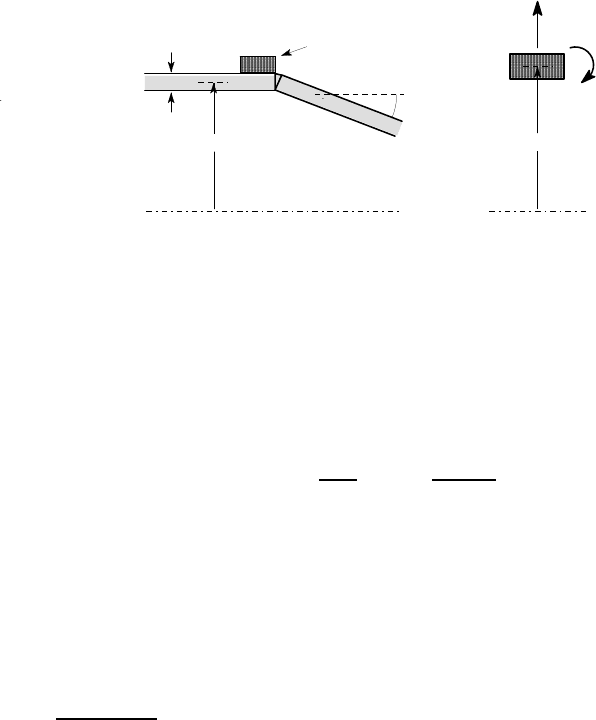
436 9 Axisymmetric Bending of Cylindrical Shells
α
is not too large. From a design perspective, a good rule of thumb is that a tran-
sition will have a significant effect in moderating bending stresses if its length (e.g.
the arc length R
α
for the toroidal transition of Figure 9.10) is about twice the decay
length l
0
.
9.6.2 Reinforcing r ings
If a discontinuous change in slope
α
is unavoidable in a shell design, the stress
concentration at the transition can be reduced by using a reinforcing ring, as shown
in Figure 9.12 (a). The ring resists the tendency for the shell to pull in locally at the
discontinuity under the influence of the axial loading of the shell and thereby reduces
both the circumferential membrane stress
σ
2
and the local bending stresses.
α
reinforcing
ring
a
t
a
b
c
0
u , F
r
θ, M
0
(a) (b)
Figure 9.12: (a) Cone/cylinder transition reinforced by a ring; (b) deformation of the
ring due to a radial force and a moment
A rigorous analysis of the geometry of Figure 9.12 (a) requires that the ring be
treated as an elastic member whose rotation
θ
and radial expansion u
r
are functions
of applied moment and radial load. For example, if the ring has a rectangular cross
section b×c as shown in Figure 9.12 (b), elementary calculations
6
show that
u
r
=
F
0
a
2
Ebc
;
θ
=
12M
0
a
2
Eb
3
c
, (9.35)
where F
0
,M
0
are respectively the radial force per unit circumference and the moment
per unit circumference.
However, if the ring is fairly substantial compared with the shell (b,c ≫t), it can
reasonably be approximated as rigid, in which case both shell segments have built in
end conditions [u
r
(0)=
θ
(0)= 0].
Reinforcing rings can also be used to reduce the circumferential membrane stress
in a cylindrical shell by restraining radial expansion. Figure 9.13 shows the deformed
shape of a shell stiffened in this way.
6
see Problems 9.12, 9.13 below.
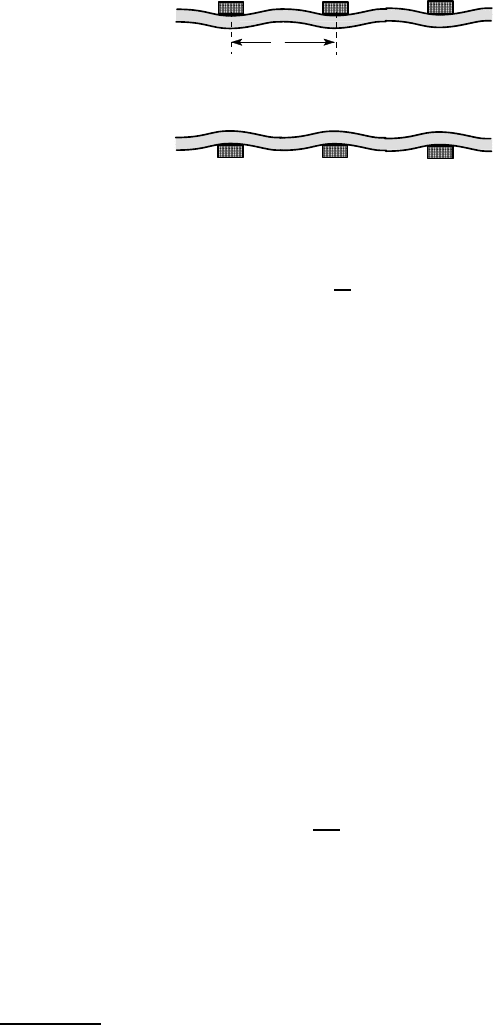
9.7 Thermal stresses 437
s
internal pressure p
Figure 9.13: Thin cylindrical shell stiffened by rings
To be effective, the rings must be sufficiently closely spaced to ensure that the
maximum radial displacement between rings is significantly lower than the unre-
stricted membrane displacement u
m
r
. It can be shown
7
that this condition is satisfied
if
β
s< 1 and hence the spacing s< 0.78
√
at.
9.7 Thermal stresses
Thin-walled vessels are often used for chemical processes and as components of
thermal machines (e.g. boilers and heat exchangers). In these applications, additional
loading will generally result from temperature gradients in the shell. Two distinct
forms of thermal loading can be identified in an axisymmetric shell:-
(i) If there is heat flow through the wall thickness (e.g. as in a heat exchanger tube)
there will be a radial temperature gradient which will induce additional shell
bending stresses.
(ii) Even if the temperature is uniform through the thickness, axial temperature gra-
dients will affect the membrane radial displacement u
m
r
in equation (9.24) and
hence change the bending stress distribution.
These effects can be characterized by a temperature function of the form
∆
T (
η
,z) = T
0
(z) +
η
T
1
(z) . (9.36)
With this notation, the outward heat flux per unit area through the shell wall is
q(z) = −K
∂
T
∂η
= −KT
1
(z) , (9.37)
where K is the thermal conductivity of the shell material.
We recall from equations (1.14–1.16) that the effect of a local increase of temper-
ature
∆
T is to produce normal strains in all three directions of magnitude
α∆
T . We
can therefore generalize the preceding derivations by adding in these thermal strains
at each point where Hooke’s law was invoked — notably in equations (9.7, 9.10).
The new version of (9.7) is
7
The problem is analogous to Problem 7.23.

438 9 Axisymmetric Bending of Cylindrical Shells
u
r
a
= e
θθ
=
σ
θθ
−
νσ
zz
E
+
α∆
T
=
σ
2
−
νσ
1
E
+
α
T
0
+
12(M
θ
−
ν
M
z
)
Et
3
+
α
T
1
η
.
The condition that u
r
be independent of
η
then yields
M
θ
=
ν
M
z
−
Et
3
α
T
1
12
(9.38)
u
r
=
σ
2
−
νσ
1
E
+
α
T
0
a . (9.39)
Equation (9.10) is generalized to
du
z
dz
−
η
d
2
u
r
dz
2
=
σ
zz
−
νσ
θθ
E
+
α
T
=
(
σ
1
−
νσ
2
)
E
+
α
T
0
+
12(M
z
−
ν
M
θ
)
Et
3
+
α
T
1
η
. (9.40)
Equating coefficients of
η
and using (9.38), we then have
du
z
dz
=
(
σ
1
−
νσ
2
)
E
+
α
T
0
(9.41)
M
z
= −D
d
2
u
r
dz
2
+
α
(1 +
ν
)T
1
. (9.42)
A similar derivation to that in §9.4 then leads to the results
σ
2
=
Eu
r
a
+
νσ
1
−E
α
T
0
(9.43)
V = −D
d
3
u
r
dz
3
+
α
(1 +
ν
)
dT
1
dz
(9.44)
d
4
u
r
dz
4
+ 4
β
4
u
r
= 4
β
4
u
m
r
−
α
(1 +
ν
)
d
2
T
1
dz
2
, (9.45)
where the membrane displacement is
u
m
r
=
pa
2
Et
−
νσ
1
a
E
+
α
T
0
a . (9.46)
We see from these results that the term T
0
(z) in equation (9.36) affects the bend-
ing solution only through the membrane displacement u
m
r
. Once this has been cal-
culated, the solution procedure is identical to that described in §9.4. In particular,
bending stresses will be induced only at ends or discontinuities if T
0
is a constant or
a linear function of z.
By contrast, the through-thickness temperature gradient T
1
(z) influences both
the governing equation (9.45) and the moment-curvature relation (9.42) and it will
always give rise to thermally induced bending stresses.
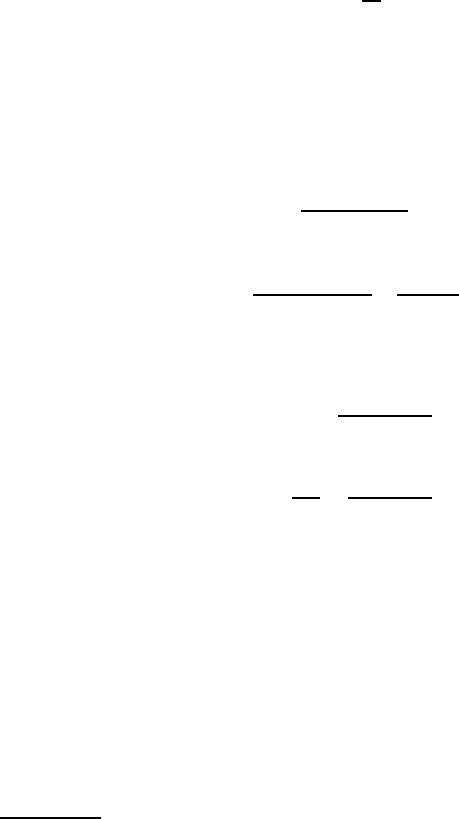
9.8 The ASME pressure vessel code 439
Example 9. 3
A long cylindrical heat exchanger tube of radius a and thickness t transmits a con-
stant heat flux q
0
per unit area throughout its length. The temperature is independent
of the axial coordinate z. Find the maximum bending stress in the tube if the material
has Young’s modulus E, Poisson’s ratio
ν
, thermal conductivity K, and coefficient of
thermal expansion
α
. There is no other loading of the shell.
In this case, we have
T
1
(z) = −
q
0
K
,
from equation (9.37) and there is no axial temperature variation (T
0
=0), so the mem-
brane displacement u
m
r
=0, from (9.46).
Substituting for T
1
into (9.45), we find that the right hand side of this equation is
zero. It follows that u
r
= 0 is a particular integral of this equation and it is also the
complete solution, since the tube is ‘long’, i.e the ends are far enough away not to
influence the solution. We then have
M
z
=
α
(1 +
ν
)q
0
D
K
,
from (9.42) and
M
θ
=
α
(1 +
ν
)
ν
q
0
D
K
+
Et
3
α
q
0
12K
,
from (9.38).
Substituting for D and simplifying, we have
M
z
= M
θ
=
α
q
0
Et
3
12K(1 −
ν
)
and
σ
max
=
6M
t
2
=
α
q
0
Et
2K(1 −
ν
)
.
9.8 The ASME pressure vessel code
The consequences of pressure vessel failure can be extremely serious, particularly
where toxic and/or high temperature fluids are involved. Designs are therefore usu-
ally based on standardized procedures described in the American Society of Me-
chanical Engineers’ pressure vessel code.
8
Conformity to the code is also usually a
requirement for obtaining liability insurance for the design. The recommendations
of the code have evolved over many years, but in the area of stress analysis they are
largely based on shell bending calculations such as those described in the present
chapter.
8
ASME Boiler and Pressure Vessel Code — An American National Standard, American
Society of Mechanical Engineers, New York.
440 9 Axisymmetric Bending of Cylindrical Shells
All common shell configurations are described in the code, but it is dangerous to
use it as a substitute for thinking through the calculation process for a design. This
is particularly true if the design is in any respect unconventional. It is a sobering
thought that many code revisions have their origins in serious accidents involving
vessels that were considered by their designers and insurers to be within the code at
that time.
9.9 Summary
In this chapter, we have developed methods for determining the bending stresses
in cylindrical shells subjected to axisymmetric radial, axial or thermal loading. The
resulting governing equation has the same form as that for the bending of a beam on
an elastic foundation and, as in that case, bending stresses are generally associated
with discontinuities of geometry or loading.
Shell bending effects are important at the junction between two shells or at a point
of localized loading, such as a support. Bending stresses are typically comparable
with (and additive to) the membrane stresses and hence give stress concentration
factors of the order of 2.
The effects are extremely localized, with an axial decay length significantly
smaller than the shell radius. In design, the first step is to calculate the character-
istic decay length given by equation (9.22). This enables us to determine whether a
particular feature can be analyzed in isolation (as is usually the case).
Bending stresses at discontinuities can be reduced by using appropriate geomet-
ric transitions. The ASME Pressure Vessel Code provides detailed guidance for these
cases, but a good rule of thumb is to use a transition whose axial length is twice the
characteristic decay length.
Further reading
A.P. Boresi, R.J. Schmidt, and O.M. Sidebottom (1993), Advanced Mechanics of
Materials, John Wiley, New York, 5th edn., §10.7.
R.D. Cook and W.C. Young (1985), Advanced Mechanics of Materials, Macmillan,
New York, §§6.1–6.4.
S.P. Timoshenko and S. Woinowsky-Krieger (1959), Theory of Plates and Shells,
McGraw-Hill, New York, 2nd edn., §§114–119.

Problems 441
Problems
Sections 9.1–9.4
9.1. Develop a more rigorous version of the analysis of equations (9.7–9.8) noting
that
(i) The circumferential strain
e
θθ
=
u
r
r
=
u
r
a +
η
and this expression should be used in place of u
r
/a in the left-hand side of equa-
tion (9.7).
(ii) The membrane stresses
σ
1
,
σ
2
will generate Poisson’s ratio strains
e
rr
=
∂
u
r
∂
r
=
∂
u
r
∂η
= −
ν
(
σ
1
+
σ
2
)
E
.
Show that this leads to the modified equation
(M
θ
−
ν
M
z
) = −
t
3
(1 +
ν
)
σ
2
12a
in place of (9.8), and explain why this correction is negligible in view of the assump-
tion t ≪ a.
9.2. Figure P9.2 shows the design for the attachment of an 8 in diameter pipe to
a cylindrical tank. The end of the pipe and the aperture in the tank are stiffened
sufficiently for this region to afford a rigid (built-in) support to the end of the pipe.
Find the maximum tensile stress in the pipe when the internal pressure is 300 psi
(E = 30×10
6
psi,
ν
=0.3).
8"
diameter
1
8
-
"
thick
Figure P9.2
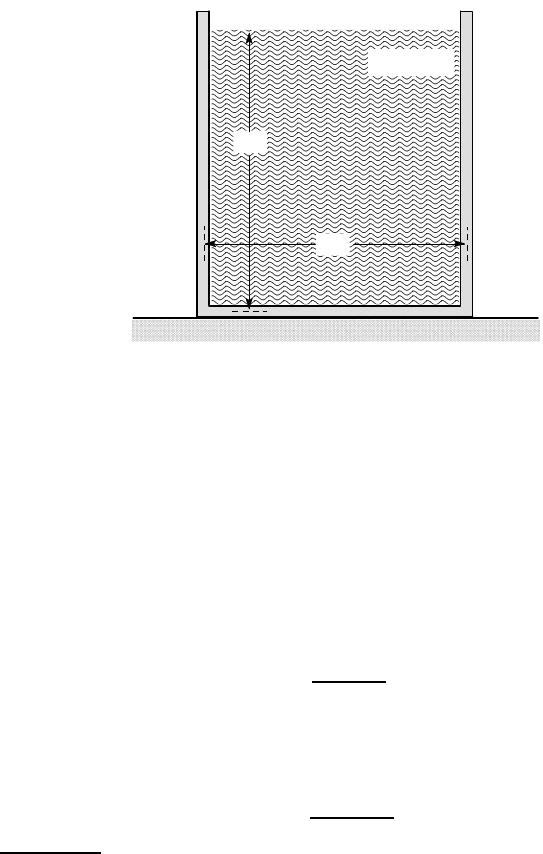
442 9 Axisymmetric Bending of Cylindrical Shells
9.3. The vertical cylindrical water tank of Figure P9.3 is made from galvanized steel
(E = 30×10
6
psi,
ν
= 0.3) of thickness 1/16 inch. The bottom of the tank is a flat
steel plate which is sufficiently rigid in extension to prevent radial displacement at
the bottom, but which affords no restraint against rotation,
θ
.
Find the location and magnitude of the maximum radial displacement of the tank
when it is just full of water of density 62.5 lbs per ft
3
. Find also the maximum tensile
stress in the tank.
Figure P9.3
9.4. A cylindrical pressure vessel of radius 700 mm and wall thickness 8 mm has
rigid end plates that can be considered to give built-in end conditions to the shell.
Find the maximum tensile stress, if the internal pressure is 1.2 MPa and the material
is steel (E = 210 GPa,
ν
=0.3).
9.5*. The analysis of the bending of circular plates shows that a moment M
0
per unit
circumference applied to the edge of a plate of radius a and thickness t, as shown in
Figure P9.5, produces a local rotation
9
θ
=
M
0
a
D(1 +
ν
)
,
where the stiffness of the plate D is defined by equation (9.14). A similar plate,
simply supported around the edge and loaded by a uniform pressure p
0
experiences
an edge rotation
θ
1
=
p
0
a
3
8D(1 +
ν
)
.
9
See S.P. Timoshenko and S. Woinowsky-Krieger (1959) Theory of Plates and Shells,
McGraw-Hill, New York, 2nd edn., §15, §16.
3
62.5 lb/ft
4 ft
3 ft
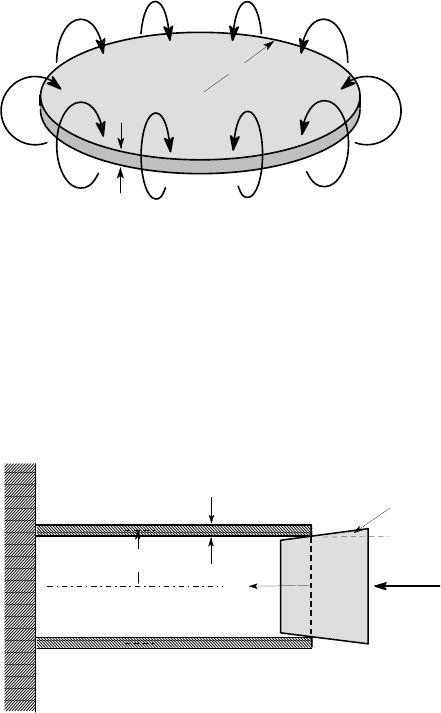
Problems 443
a
M
θ
, θ
t
.
Figure P9.5
Two such plates are used to close the ends of a cylindrical shell of the same
radius, thickness and material properties. Find an expression for the bending moment
M
0
at the shell/plate junction when the vessel is subjected to an internal pressure p
0
.
Assume that the end plates completely resist radial expansion at the junction.
9.6. A rigid conical wedge is driven into a cylindrical tube by an axial force F
0
, as
shown in Figure P9.6. The wedge angle
α
≪1 and the coefficient of friction at the
contact point is f .
Figure P9.6
Assuming that contact occurs only at the end of the tube as shown, find an expres-
sion for the radial displacement of the tube u
r
as a function of z and F
0
. Hence show
that there is a minimum angle
α
for which contact is restricted to the end and find
it’s value. The cylinder has a radius a and thickness t and the material has Young’s
modulus E and Poisson’s ratio
ν
.
Sections 9.5, 9.6
9.7. A compressed air storage tank comprises a cylindrical segment and two hemi-
spherical ends, each of radius 300 mm and wall thickness 4 mm. Find the maximum
tensile stress in the tank when the internal pressure is 25 bar (1 bar = 100 kPa, E =210
GPa,
ν
=0.3).
z
α
F
0
a
t
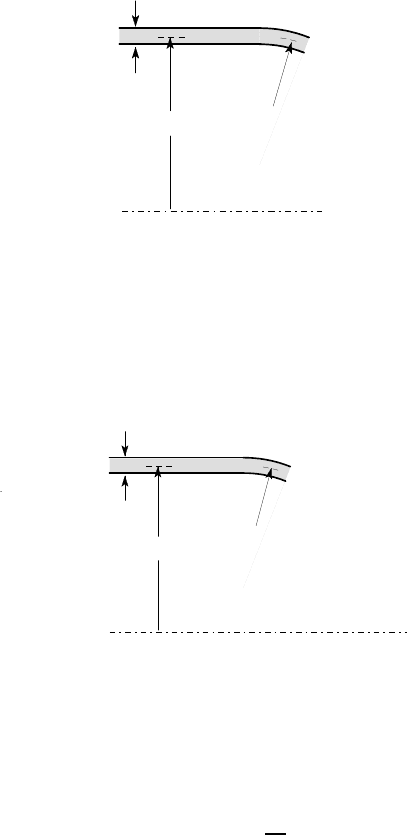
444 9 Axisymmetric Bending of Cylindrical Shells
9.8. A toroidal shell of radius R is joined to a cylindrical shell of radius a, as shown
in Figure P9.8. Both segments have thickness t and the shell is loaded by an internal
pressure p
0
. Find the required value of R as a function of a,t, p
0
, if the maximum
axial stress
σ
max
zz
is to be just equal to the membrane stress
σ
2
in the cylindrical
segment, distant from the transition.
a
t
R
.
0
internal pressure p
Figure P9.8
9.9. Find the maximum tensile stress for the cylindrical/toroidal transition of Figure
P9.9 if the vessel is loaded by an internal pressure of 800 kPa. The shell thickness is
7 mm and the material is steel (E =210 GPa,
ν
=0.3).
7 mm
250 mm
800 mm
Figure P9.9
9.10. To reduce the bending stresses at a transition between a cylindrical shell of
radius a and a hemispherical shell, a transition region is proposed in which the radius
R
1
=
ba
z
,
as shown in Figure P9.10.
